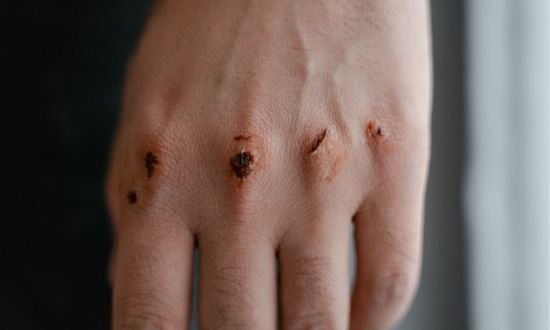Dog bite scars reminds us of the traumatic events happened because of over beloved pet. Dogs are widely known as a symbol of loyalty and friendship. However, even the gentlest of dogs can react inappropriately if they get provoked or frightened which can result in unfortunate dog bites. In this article, we’ll discuss in detail about dog bite scars focusing on various types of scars, their causes, available treatment options, and effective strategies for prevention. Moreover, understanding how to remove and reduce these scars for our physical and emotional well-being .

Table of Contents
1. Understanding Dog Bite Scars:
The first step in handling a dog bite occurrence is to recognize the symptoms of dog bite scars. Scar are formed as a result of the healing process of wound after a dog bit incident. There are multiple factors which plays their role in type and severity of scar which includes dog’s breed, depth of the wound and immediate care done for the wound. Having detailed knowledge of this process will help you in better management of dog bite scars. To learn more about dog bite disease and management do follow

A. Mechanism of Dog Bite Scars Formation:
When a dog bites, its teeth puncture the skin and internal tissues, causing damage that triggers a series of biological responses aimed at repairing the injured area. The body’s immediate response is inflammation, characterized by redness, swelling and pain, as the immune system rushes to the scene to remove debris and initiate the healing process. As the wound goes through the stages of proliferation and remodeling, scar tissue forms.
B. Types of Dog Bite Scars:
Dog bite scars are primarily caused by the forceful jaws of a dog during an attack. This force can result in various types of scar tissue formation, including:
- Hypertrophic scars:
a. Characteristics: Hypertrophic scars are raised, thick and usually red or pink in color. They often develop within weeks of a dog bite injury.
b. Cause: These scars are a result of overproduction of collagen during the wound healing process. - Keloid scars:
a. Characteristics: Keloid scars are more pronounced than hypertrophic scars. They spread beyond the boundaries of the original lesion and are usually dark in color. They can cause itching and discomfort.
b. Cause: Keloid scars are the result of excessive and uncontrolled growth of collagen in the wound area. - Atrophic scars:
a. Characteristics: Atrophic scars appear sunken and depressed compared to the surrounding skin. They often result from tissue damage in the area of the wound.
b. Cause: These marks are usually caused by destruction of skin tissue, which can occur from deep dog bites. - Contracture scars:
a. Characteristics: Contracture marks appear when the skin becomes hard and tight, limiting movement in the affected area. These marks are common in burn injuries but can also occur from deep dog bites.
b. Cause: Contraction scars form when the skin heals with too much stress or when the underlying tissue is damaged. - Fine line Scars:
- a. Characteristics: A fine line scar, often called a flat line scar, is a type of scar that presents as a thin, pale, and almost imperceptible mark on the surface of the skin. These scars are usually the least noticeable of the different types of scars. Mostly these scars forms due to scratches or common everyday injuries.
- b. Cause: Fine scars are often the result of a well-healed wound where the body’s natural healing process has effectively reattached the collagen fibers, creating a smooth and even skin texture.
| Types of Dog Bite Scars | Characteristics | Treatment Options |
| Hypertrophic Scar | – Raised, thick, and red -Develops within weeks of injury – May gradually fade over time | – Silicone gel sheets – Corticosteroid injections – Laser therapy – Surgical revision |
| Keloid Scar | – More pronounced than hypertrophic – Extends beyond the wound borders – Darker in color – May itch or cause discomfort | – Silicone gel sheets – Corticosteroid injections – Laser therapy – Surgical revision |
| Atrophic Scar | – Sunken and depressed appearance – Results from a loss of tissue | – Aloe vera gel – Vitamin E cream – Surgical revision (in severe cases) |
| Contracture Scar | – Skin tightens and constricts – Limits mobility in the area | – Physical therapy – Scar massage – Splinting or pressure garments – Surgical revision (in severe cases) |
C. Factors Influencing Scar Formation:
Several factors can influence the formation of dog bite scars, including:
- Depth and Location of the Wound: The severity and location of the dog bite play a major role in scar formation.
- Individual Healing Process: Each person’s body heals differently, which affects the extent and appearance of scars.
- Age: Younger people heal more effectively and are more likely to have less scarring.
- Genetic: Genetic factors can determine how the body reacts to wounds, possibly influencing scar formation.
D. Understanding the Healing Process:
Before discussing the treatment options, it’s important to understand the natural healing process of dog bite wounds and scars. When a dog bite occurs, the body initiates a series of complex biological responses to repair the damaged tissue. Here is a brief overview of the steps:
- Inflammation:
Inflammation is the first response of body to the injury. This includes redness, swelling, and pain as the body immune system will try to initiate the healing process. - Spread:
During this phase, collagen production will increase and new tissues will be formed. new tissues are formed, and collagen production increases. This will lead to gradual closing of the wound and subsequently formation of scar tissue will start. Proper wound care during this phase is very important to minimize scarring. - Remodeling:
The final stage involves remodeling of the scar tissue. In this phase collagen fibers will reorganize which will lead to change in appearance and texture of scar over time.
2. Treatment of Dog Bite Scars:
A. Early Wound Care Of Dog Bite:
Proper care of a dog bite wound is important in reducing the likelihood of severe scarring. The initial steps to take include:
- Immediate Wound Cleansing: Thoroughly wash the wound with mild soap and water to remove any bacteria or contaminants.
- Applying Antibiotic Ointment: Apply a thin layer of antibiotic ointment to prevent infection.
- Covering the Wound: Use a sterile bandage or dressing to protect the wound from further exposure.
B. Topical Treatments Of Dog Bite Scars:
- Silicone gel sheets: Silicone gel sheets can help flatten and soften scars. They are applied directly to the scar and must be used continuously for several weeks.
- Vitamin E Cream: Some people find relief from dog bite scars by applying vitamin E cream regularly. This can help in improving the appearance of scars over time.
C. Medical Interventions:
- Corticosteroid injections: A dermatologist may recommend corticosteroid injections to reduce the size and redness of hypertrophic or keloid scars.

- Laser therapy: Laser therapy can help reduce the appearance of scars by targeting scar tissue and stimulating collagen production.
- Surgical revision: In case of severe injuries, surgical revision can be done. This involves removing old scar tissue and closing the wound more precisely.
D. Natural Remedies for Dog Bite Scars:
- Aloe Vera Gel: Aloe Vera has soothing properties and can be applied to wounds to promote healing and reduce inflammation.
- Honey: Honey is known for its antibacterial properties and can help heal blemishes when applied topically.
E. Self-Care for Dog Bite Scars:
In addition to medical treatment, there are several self-care measures that can help reduce scarring:
- Scar massage: Gently massaging the scar tissue can help break down excess collagen and improve blood circulation, promoting scar remodeling.
- Sun Protection: Protecting the scarred area from sunlight can prevent further discoloration and slow down the skin’s aging process.
3. Emotional Healing and Support:
Dealing with dog bite scars goes beyond physical therapy. Emotional healing is equally important in the recovery process. Seeking help from loved ones, joining support groups, or even seeking professional counseling can help individuals cope with the psychological effects of dog bite scars.
4. Prevention Strategies:
Preventing dog bite scars starts with responsible pet ownership and understanding dog behavior. Here are some key prevention strategies:
- Training and socialization:
Properly train and socialize your dog from an early age to reduce the likelihood of aggressive behavior. - Monitoring:
Always supervise interactions between dogs and children to prevent accidents that could lead to bites. - Dog bite prevention education:
Educate yourself and your family members about your dog’s body language and signs of stress so you can avoid situations that may provoke the dog. - Get professional help:
If you adopt a rescue dog with a history of aggression, consult a professional dog trainer or behaviorist to address any underlying issues.
5. Consulting Legal Expert for Dog Bite Scars Compensation:
Seeking legal help in a dog bite case can be an important step for individuals who have experienced these injuries. When a dog bite results in scarring, it often raises complex legal questions regarding liability and compensation.
Usually owner of the dog is responsible of the injuries caused by the pet. Consulting Legal experts specializing in personal injury and dog bite cases can provide valuable guidance in dealing with the legal aspects of such incidents.
6. Conclusion:
Finally, dog bite scars can be physically and emotionally difficult. However, with the right knowledge, care and treatment, you can minimize their effects and help your skin heal as beautifully as possible. By implementing proper wound care, considering medical treatment, seeking self-care treatments, and seeking emotional support, individuals can work to reduce the long-term effects of dog bite scars. . It is important to consult a medical professional for management of dog bite scars. Remember that even though scars may fade, the love and companionship between humans and dogs remains, making it worth the effort to prevent dog bites and their potential scars.
Disclaimer:
Content on this site is written with thorough research and keeping in mind latest guidelines. However, No content on this site should Substitute Professional Consultation.
